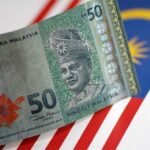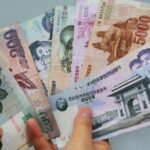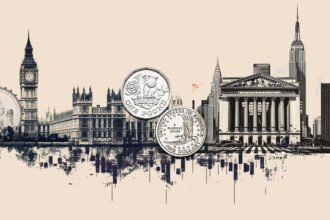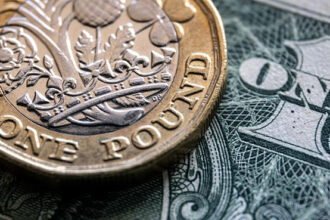- GBP/USD trades in a narrow channel below 1.3000 on Thursday.
- The bearish stance remains unchanged in the near term.
- The US economic calendar will feature Initial Jobless Claims and Retail Sales data.
GBP/USD struggles to stage a recovery and stays below 1.3000 in the European session on Thursday after suffering large losses on Wednesday. The pair remains technically bearish as the market focus shifts to the mid-tier macroeconomic data releases from the US.
British Pound PRICE This week
The table below shows the percentage change of British Pound (GBP) against listed major currencies this week. British Pound was the weakest against the US Dollar.
| USD | EUR | GBP | JPY | CAD | AUD | NZD | CHF | |
|---|---|---|---|---|---|---|---|---|
| USD | 0.80% | 0.70% | 0.49% | 0.09% | 1.08% | 0.94% | 0.98% | |
| EUR | -0.80% | -0.18% | -0.39% | -0.62% | 0.31% | 0.05% | 0.08% | |
| GBP | -0.70% | 0.18% | -0.23% | -0.58% | 0.51% | 0.24% | 0.24% | |
| JPY | -0.49% | 0.39% | 0.23% | -0.41% | 0.61% | 0.50% | 0.48% | |
| CAD | -0.09% | 0.62% | 0.58% | 0.41% | 0.94% | 0.88% | 0.71% | |
| AUD | -1.08% | -0.31% | -0.51% | -0.61% | -0.94% | -0.13% | -0.14% | |
| NZD | -0.94% | -0.05% | -0.24% | -0.50% | -0.88% | 0.13% | -0.03% | |
| CHF | -0.98% | -0.08% | -0.24% | -0.48% | -0.71% | 0.14% | 0.03% |
The heat map shows percentage changes of major currencies against each other. The base currency is picked from the left column, while the quote currency is picked from the top row. For example, if you pick the British Pound from the left column and move along the horizontal line to the US Dollar, the percentage change displayed in the box will represent GBP (base)/USD (quote).
Softer-than-forecast September inflation readings from the UK on Wednesday caused investors to start pricing in multiple Bank of England (BoE) rate cuts this year, triggering a Pound Sterling selloff.
Early Thursday, the cautious market mood helps the US Dollar (USD) stay resilient against its rivals and makes it difficult for GBP/USD to gain traction. In the second half of the day, September Retail Sales and the weekly Initial Jobless Claims data from the US will be watched closely by market participants.
The number of first-time applications for unemployment benefits is forecast to stay unchanged at 258,000 in the week ending October 12. A noticeable decline in this data, with a print below 220,000, could boost the USD and force GBP/USD to stretch lower. On the other hand, a reading near or above the market expectation could pave the way for a weaker USD. In this scenario, GBP/USD could retrace a portion of its weekly decline.
GBP/USD Technical Analysis
The Relative Strength Index (RSI) indicator on the 4-hour chart stays below 40, suggesting that the bearish stance holds. On the downside, 1.2950-1.2940 (100-day Simple Moving Average (SMA), static level) forms a strong support area ahead of 1.2900 (static level, round level).
In case GBP/USD manages to rise above 1.3000 (round level, static level) and stabilizes there, sellers could be discouraged. In this scenario, 1.3050 (static level) could be seen as next resistance before 1.3100 (round level, static level).
Pound Sterling FAQs
The Pound Sterling (GBP) is the oldest currency in the world (886 AD) and the official currency of the United Kingdom. It is the fourth most traded unit for foreign exchange (FX) in the world, accounting for 12% of all transactions, averaging $630 billion a day, according to 2022 data. Its key trading pairs are GBP/USD, also known as ‘Cable’, which accounts for 11% of FX, GBP/JPY, or the ‘Dragon’ as it is known by traders (3%), and EUR/GBP (2%). The Pound Sterling is issued by the Bank of England (BoE).
The single most important factor influencing the value of the Pound Sterling is monetary policy decided by the Bank of England. The BoE bases its decisions on whether it has achieved its primary goal of “price stability” – a steady inflation rate of around 2%. Its primary tool for achieving this is the adjustment of interest rates. When inflation is too high, the BoE will try to rein it in by raising interest rates, making it more expensive for people and businesses to access credit. This is generally positive for GBP, as higher interest rates make the UK a more attractive place for global investors to park their money. When inflation falls too low it is a sign economic growth is slowing. In this scenario, the BoE will consider lowering interest rates to cheapen credit so businesses will borrow more to invest in growth-generating projects.
Data releases gauge the health of the economy and can impact the value of the Pound Sterling. Indicators such as GDP, Manufacturing and Services PMIs, and employment can all influence the direction of the GBP. A strong economy is good for Sterling. Not only does it attract more foreign investment but it may encourage the BoE to put up interest rates, which will directly strengthen GBP. Otherwise, if economic data is weak, the Pound Sterling is likely to fall.
Another significant data release for the Pound Sterling is the Trade Balance. This indicator measures the difference between what a country earns from its exports and what it spends on imports over a given period. If a country produces highly sought-after exports, its currency will benefit purely from the extra demand created from foreign buyers seeking to purchase these goods. Therefore, a positive net Trade Balance strengthens a currency and vice versa for a negative balance.






















